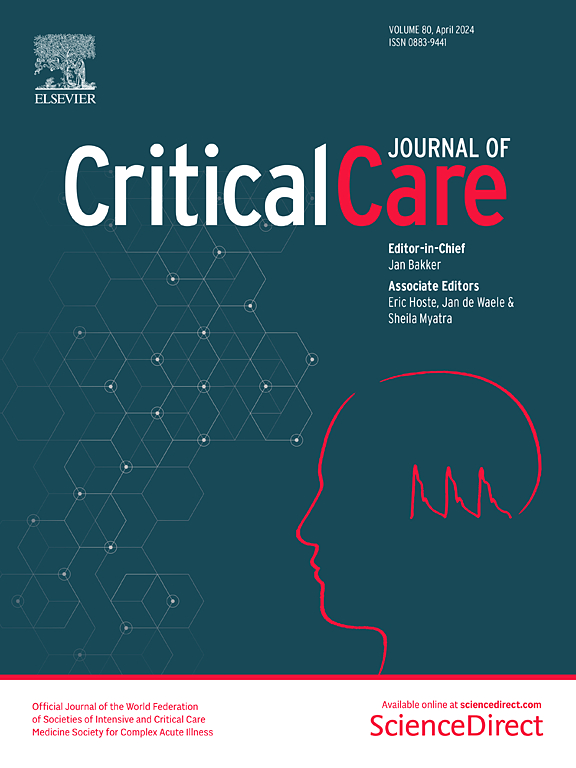Subphenotyping prone position responders with machine learning
IF 8.8
1区 医学
Q1 CRITICAL CARE MEDICINE
引用次数: 0
Abstract
Acute respiratory distress syndrome (ARDS) is a heterogeneous condition with varying response to prone positioning. We aimed to identify subphenotypes of ARDS patients undergoing prone positioning using machine learning and assess their association with mortality and response to prone positioning. In this retrospective observational study, we enrolled 353 mechanically ventilated ARDS patients who underwent at least one prone positioning cycle. Unsupervised machine learning was used to identify subphenotypes based on respiratory mechanics, oxygenation parameters, and demographic variables collected in supine position. The primary outcome was 28-day mortality. Secondary outcomes included response to prone positioning in terms of respiratory system compliance, driving pressure, PaO2/FiO2 ratio, ventilatory ratio, and mechanical power. Three distinct subphenotypes were identified. Cluster 1 (22.9% of whole cohort) had a higher PaO2/FiO2 ratio and lower Positive End-Expiratory Pressure (PEEP). Cluster 2 (51.3%) had a higher proportion of COVID-19 patients, lower driving pressure, higher PEEP, and higher respiratory system compliance. Cluster 3 (25.8%) had a lower pH, higher PaCO2, and higher ventilatory ratio. Mortality differed significantly across clusters (p = 0.03), with Cluster 3 having the highest mortality (56%). There were no significant differences in the proportions of responders to prone positioning for any of the studied parameters. Transpulmonary pressure measurements in a subcohort did not improve subphenotype characterization. Distinct ARDS subphenotypes with varying mortality were identified in patients undergoing prone positioning; however, predicting which patients benefited from this intervention based on available data was not possible. These findings underscore the need for continued efforts in phenotyping ARDS through multimodal data to better understand the heterogeneity of this population.利用机器学习对俯卧体位反应者进行亚表型分析
急性呼吸窘迫综合征(ARDS)是一种异质性疾病,对俯卧位的反应各不相同。我们的目的是利用机器学习识别接受俯卧位的 ARDS 患者的亚型,并评估它们与死亡率和对俯卧位反应的关系。在这项回顾性观察研究中,我们招募了 353 名接受过至少一次俯卧位循环的机械通气 ARDS 患者。根据仰卧位收集的呼吸力学、氧合作用参数和人口统计学变量,采用无监督机器学习来识别亚型。主要结果是 28 天死亡率。次要结果包括在呼吸系统顺应性、驱动压力、PaO2/FiO2 比值、通气比值和机械力方面对俯卧位的反应。研究发现了三种不同的亚型。第一组(占整个组群的 22.9%)PaO2/FiO2 比率较高,呼气末正压(PEEP)较低。第 2 组(51.3%)的 COVID-19 患者比例较高,驱动压力较低,PEEP 较高,呼吸系统顺应性较高。第 3 组(25.8%)的 pH 值较低,PaCO2 值较高,通气比值较高。各组死亡率差异明显(p = 0.03),其中第 3 组死亡率最高(56%)。在所有研究参数中,对俯卧位有反应者的比例均无明显差异。在亚群中测量跨肺压并不能改善亚型特征。在接受俯卧位的患者中发现了不同死亡率的 ARDS 亚型;但是,根据现有数据无法预测哪些患者能从这种干预中获益。这些发现突出表明,需要继续努力通过多模态数据对 ARDS 进行表型分析,以更好地了解这一人群的异质性。
本文章由计算机程序翻译,如有差异,请以英文原文为准。
求助全文
约1分钟内获得全文
求助全文
来源期刊

Critical Care
医学-危重病医学
CiteScore
20.60
自引率
3.30%
发文量
348
审稿时长
1.5 months
期刊介绍:
Critical Care is an esteemed international medical journal that undergoes a rigorous peer-review process to maintain its high quality standards. Its primary objective is to enhance the healthcare services offered to critically ill patients. To achieve this, the journal focuses on gathering, exchanging, disseminating, and endorsing evidence-based information that is highly relevant to intensivists. By doing so, Critical Care seeks to provide a thorough and inclusive examination of the intensive care field.
 求助内容:
求助内容: 应助结果提醒方式:
应助结果提醒方式:


